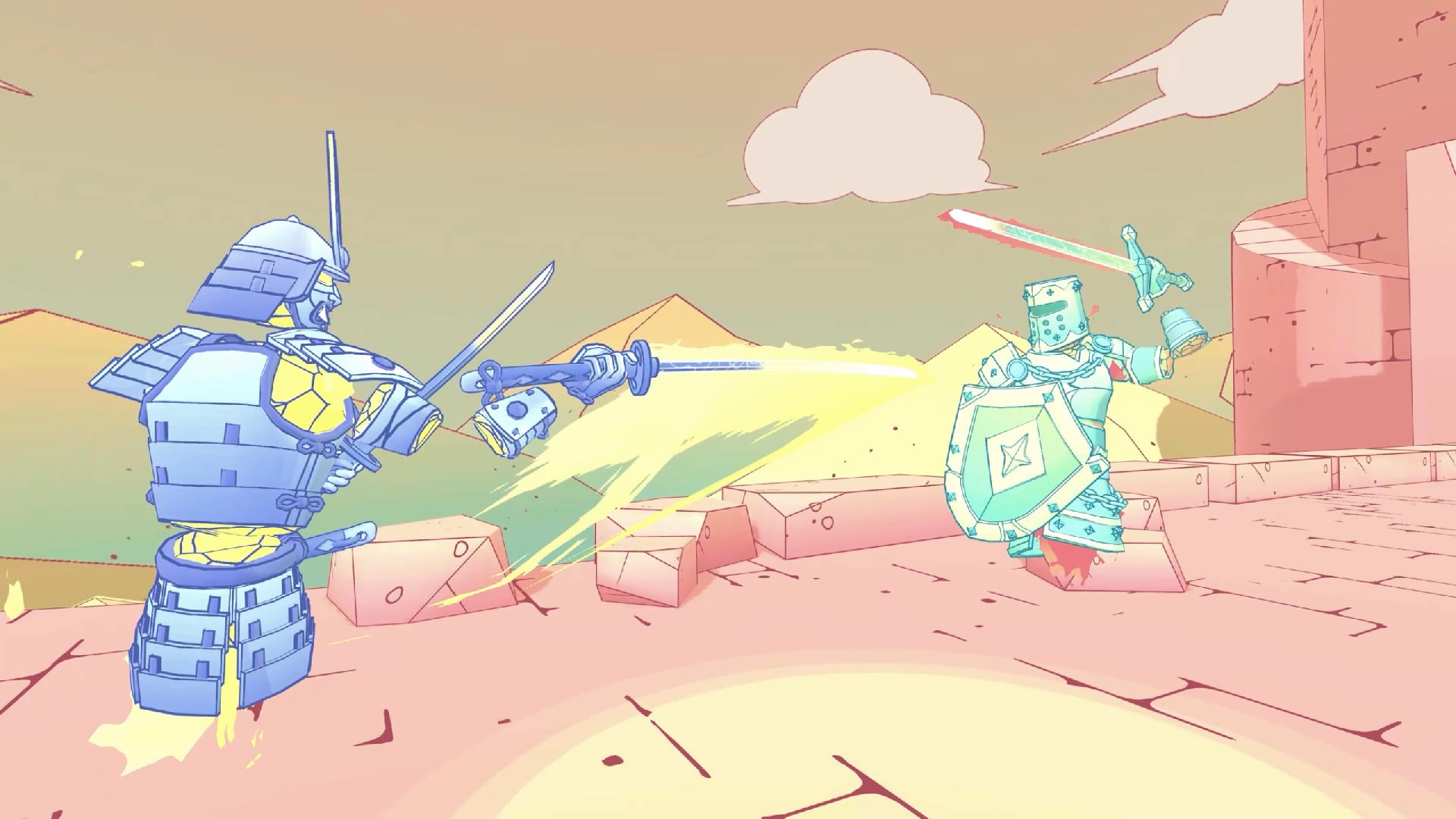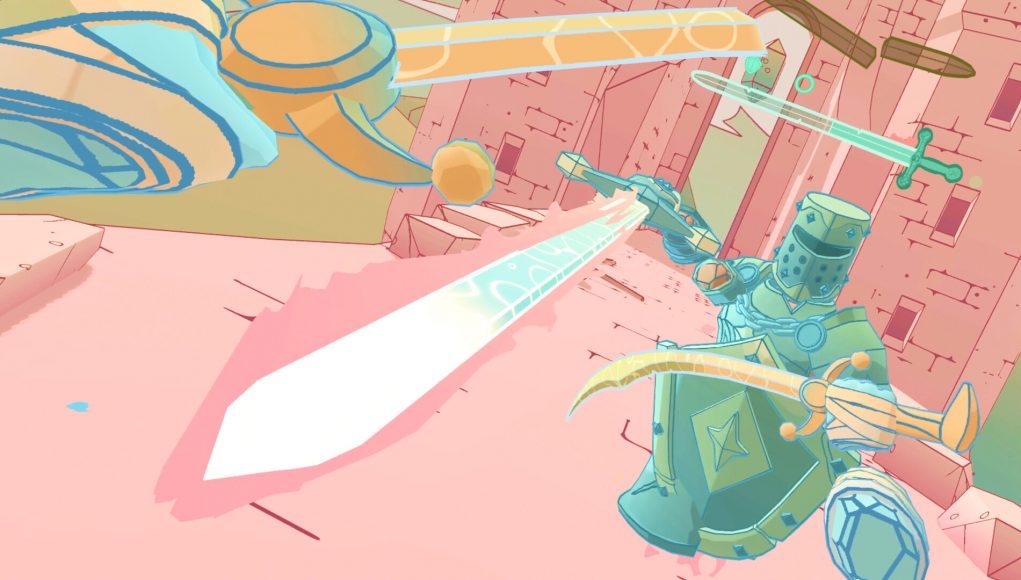Broken Edge is a sword fighting simulator that throws you into an arena and pits you against either an AI or online competitor for some mano a mano dueling action. Distinct classes make for awesome vehicles for roleplay, as they force you to use specific fighting styles, although the sword-swinging experience can feel somewhat transient since crossing blades may be a little too unintentional at times.
Broken Edge Details:
Available On: Quest 2, Steam
Release Date: November 17th, 2022
Price: $10
Developer: Trebuchet Games
Publisher: Fast Travel Games
Reviewed On: Quest 2
Gameplay
Broken Edge is very much a multiplayer-focused game, although it does offer a single player campaign that challenges you to use every class through structured battles and level up against all other classes. If you’re looking for a robust single-player experience, you may not find it in Broken Edge, although AI does make for good sparring partners that will teach you the ropes of each of the game’s various classes.
At launch, five basic classes are playable in both multiplayer and solo mode: a dual-katana Samurai, a long sword using Barbarian, a Knight with dual swords and shield, a Persian with dual scimitar, and a Duelist with rapier and cutlass. There’s also the Tyrant with a mighty Zweihänder, although that class is only available as a playable character once you’ve reached a high enough rank. Broken Edge makes it easy to step into roleplaying, as you’ll naturally feel the vibe of each class and start tossing out slick moves you totally didn’t drudge up from the part of your brain that stores every flourish from ’80s classic film Highlander (1986).
The end goal throughout each campaign run is to see whether you can make it to the Tyrant. Leveling up gets you into higher ranked matches online, but more about that later.

Campaign matches pit you against four AI in succession, typically first against two classes which are best balanced against your own class and then The Tyrant. Enemies move automatically towards you while you stay in one place, so you’ll be tested on dodging ability and accuracy once enemies move their way into the kill range.
There’s two ways to go about winning any fight, and I think they’re actually pretty clever considering this isn’t a physics-based sword game—it’s more of a game of sword tag than what you might see in similar dueling games like Ironlights or Swords of Gurrah. You can gain the advantage by cutting down the other player’s sword, or go in for the kill with an ‘awakened’ (charged-up) blade. Going in for the kill with a normal blade (i.e. not flaming with an ethereal glow) will only send your opponent back to his starting place unharmed.
Blades regenerate as long as you have health on your sword icon, which is good since destroying your opponent’s blade is done by cutting as close to the hilt as possible while using the least amount of your sword’s own steel to do so. If you wanted an illustrated guide on what not to do, feast your eyes above.
As you’d imagine, making sure you don’t get a killer hilt shot is easier said than done, since enemies can sometimes surprise you and force you to instinctively parry and lose a good chunk of your health if you’re not careful.
By adopting a specific sword movement—variable according to class—you can do what’s called ‘awakening the blade’, allowing you to kill the opponent even if their sword gauge is still high and they have a functional sword in hand. That blow-back hit happened because my awakened blade didn’t follow the pattern perfectly, so I lost my charge as I came down for what should have been a death blow.
In online play this essentially offers the player two ways to go about attacking; you can choose to either maximize your accuracy with a standard blade attack, or go in for the early kill with an awakened one. On the flipside, if your opponent is always charging their blade, it could give you a better sense of where to strike as you follow their repetitions and vice versa.
Still, it’s difficult to get the hang of exactly where the game wants your sword to be to keep it awakened, leading you to swish your blade around for a while until you get into the grove of a consistent pattern and hoping that it’s more or less right. Oftentimes I’d find my sword fully awakened and immediately lose during a critical strike. Here’s an awakening move I executed pretty consistently twice in a row, the first time failing and the second time landing a victory hit.
The same goes for specific charging stances that give you a second wind, or protection during the battle. I’ll cover those more in the Immersion section below.
To be frank, Broken Edge feels like one of those games that will attract a hardcore niche of players who will stick around to keep servers populated during specific hours of the day. Its combat system encourages extreme accuracy—maybe even more so than traditional fencing—which may weed out some players from becoming long-term users. Still, it has all of the ingredients of a game that will attract fencing champs and would-be roleplayers looking to avenge their fathers (or prepare to die).
Immersion
Like all VR games, Broken Edge would benefit from better physical tactility. Not being able to feel the sword whooshing in the air and striking a foe is just a current hardware limitation that studios have to design around to make their worlds feel more solid. With its striking, charging and stance system, Broken Edge takes a good stab at making you forget you have a weightless sword in your hand, although many may find it inconsistent.
Users with optically tracked controllers like Touch may unintentionally screw themselves over, since some stances require you to swing on the very edge of the controller’s operating range, meaning you have to be keenly aware of how you hold them as to not lose tracking. Lose tracking, and you lose the accuracy required to effectively dual-hand weapons and execute charging moves—important things for all classes. Even after a few hours of playing, I still didn’t click into the exact mixture of moves the game requires me to make combined versus the moves I can technically reproduce due to instinctively overextending outside of the Quest 2’s inside-out tracking volume or obscuring my own controller doing sick Highlander moves.
Broken Edge mitigates this somewhat by offering you visual recaps of which strike landed and where, although I think I need a lot more time in the dojo and in the single-player arena before I can get that ultravital muscle memory to actually feel like I am executing moves consistently. It’s a shame, because I wanted to click into Broken Edge’s dueling as quickly as I did into its cohesive art style and expressive worlds, which feel like they’re offering a glimpse of a larger world with a bonafide backstory.
Comfort
Broken Edge is best played whilst standing up, although you can technically play seated. Every time you load up the game you go through a ‘T pose’ calibration sequence to determine your height and arm span.
Since the game has no artificial locomotion, it’s very comfortable for most everyone. It also doesn’t require a ton of movement like you might find in VR boxing titles or certain block-slashing rhythm games, so most anyone can play for extended periods without incurring too much of a sweaty facial interface.
‘Broken Edge’ Comfort Settings – November 18th, 2022 |
|
Turning |
|
| Artificial turning |  |
| Snap-turn |  |
| Quick-turn |  |
| Smooth-turn |  |
Movement |
|
| Artificial movement |  |
| Teleport-move |  |
| Dash-move |  |
| Smooth-move |  |
| Blinders |  |
| Head-based |  |
| Controller-based |  |
| Swappable movement hand |  |
Posture |
|
| Standing mode |  |
| Seated mode |  |
| Artificial crouch |  |
| Real crouch |  |
Accessibility |
|
| Subtitles |  |
| Dialogue audio |  |
| Adjustable difficulty |  |
| Two hands required |  |
| Real crouch required |  |
| Hearing required |  |
| Adjustable player height |  |







